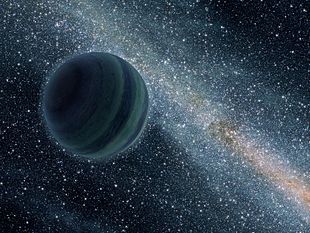
Artist's conception of a Jupiter-size rogue planet with the edge on disk of a spiral galaxy in the background. Image via the Wiki
Call it planet Crank. A study slated to be published in the Notices of the Royal Astronomical Society finds that not only are nomad planets possible, under ideal conditions some of them could be ejected from the heart of large galaxies at an appreciable fraction of the speed of light:
(Harvard) — Such speedy worlds, called hypervelocity planets, are produced in the same way as hypervelocity stars. A double-star system wanders too close to the supermassive black hole at the galactic center. Strong gravitational forces rip the stars from each other, sending one away at high speed while the other is captured into orbit around the black hole.The second star, as it’s captured by the black hole, could have its planets torn away and flung into the icy blackness of interstellar space at tremendous speeds. A typical hypervelocity planet would slingshot outward at 7 to 10 million miles per hour. However, a small fraction of them could gain much higher speeds under ideal conditions.
Such worlds could leave a large super massive black hole at upwards of 30 million miles per hour, about 8300 miles per second, or almost 5% of c.
That’s fast. Real fast. Beyond human comprehension fast. Fast enough to get from the earth to the moon in half a minute, a little over an hour to the orbit of Mars, and from one end of the solar system to another in less than a day. Residents of a hyper-velocity earth could travel from the sun to the nearest star in a single human lifetime. Planet Crank would make it from the center of the Milky Way to our solar system in about one-million years. Talk about a stellar tour, this thing would be the virtual Carnival Cruise of the cosmos. But yikes, you sure wouldn’t want it coming anywhere close to the solar system!
Seeing a hyper-velocity planet would be next to impossible without dramatic breakthroughs in detection and imaging technology. Or would it?
The kinetic energies involved in that kind of velocity turn minor impacts from a small meteor into a world-changing event and there’s plenty of small objects in the galaxy (Yes, I actually worked out the math, both relativistc and non relativistic impact energies). It’s arguable Crank wouldn’t last long, in cosmic terms, after being pummeled and eroded just by dust and gas; it would basically evaporate over time as a consequence of its tremendous energy of motion. Who knows? If it happened to plow through a relatively thick cloud, maybe it would even be visible for many light-years around. Forget erosion, I imagine the shock wave in front of it and the planet’s leading surface or atmosphere would be so energized they would be heated into plasma, perhaps even to the point of fusion.
How would that affect its rate of rotation, its size, the geometry of a magnetic field, hell its entire shape? Come, visit Planet Crank on your next off-world vacay, where the atmosphere is plasma, the surface an angry bubbling gas where grains of dust hit like anti-tank rounds, and the whole world is deformed into a celestial-sized, brightly glowing rain-drop! It doesn’t exactly beckon. But it would quite a sight from a safe distance.
Maybe we just need to know what we’re looking for, maybe someone with the requisite background could wade into the mathematics, but seems to me that whole deal might shine like a star in its own right, and the spectra would have all kinds of weird, identifiable properties.

“Fast enough to get from the earth to the moon in half a minute, a little over an hour to the orbit of Mars, and from one end of the solar system to another in less than a day.”
I’m never one to miss out on a chance to show how really big the universe is. Crank manages to traverse in less than one day around the same distance as the furthest human-made object (Voyager-1) took 30 years to travel.
Yet even at this elevated, and as you say incomprehensible, speed it would still take around EIGHTY YEARS* to get to just the nearest star.
Mike.
* One light year takes 20 years at 5%c.
Such planets plowing through interstellar gas would look like meteors—on a much bigger scale. To see one, you’d have to catch a supermassive black hole at a phase of its existence when it’s not being a quasar and gobbling up everything in sight … but isn’t completely done yet. I imagine that our own SMBH would not have such an event very often any more.
I wonder how many weeks will pass before some crank decides that we haven’t seen Niribu because it is a hyper-velocity planet.
LOL on Niribu, I may have to steal that zinger and call it my own!
A little note of history here. In 1934, authors Philip Wylie and Edwin Balmer wrote a novel entitled, “When Worlds Collide,” which was later made into a sci-fi movie in 1950 by director George Pal (and, apparently, is being remade this year).
Scientists at the time poo pooed the premise because the notion that there might be rogue planets wandering around the galaxy was considered highly unlikely. Interestingly enough, the recent discovery that there might be 100 billion or more such rogue planets in this galaxy has certainly vindicated the premise of the authors, neither of whom was a scientists of any kind, and showed that even scientists occasionally get it wrong, although, in fairness, the technology to discover such planets was non-existent at the time.
No, thanks. I’ve been to Las Vegas in August.